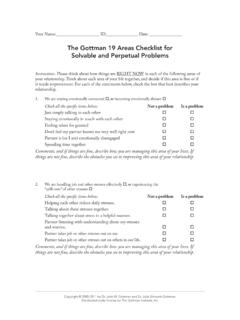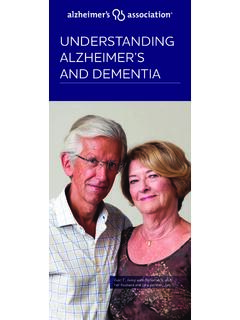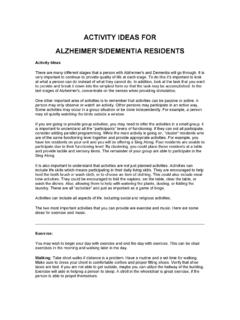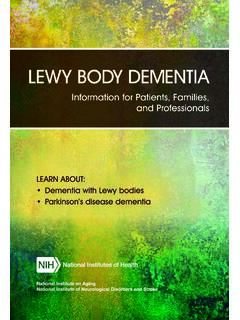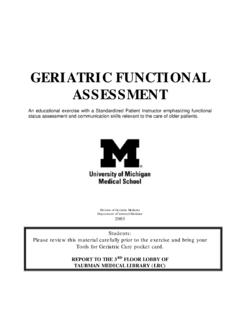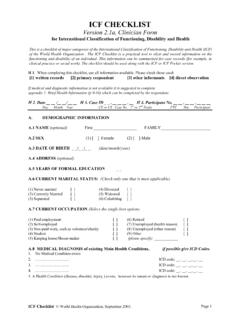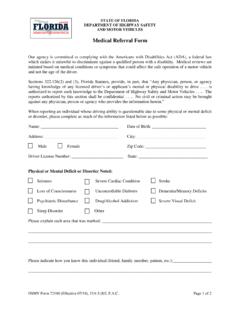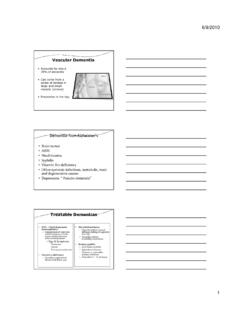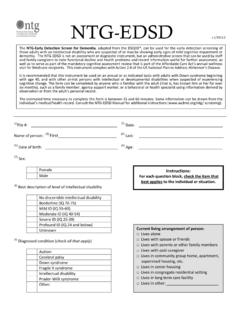Transcription of Statistical - Postpartum
1 Postpartum Support International June 2013 Page 1 Postpartum Depression and Perinatal Mood Disorders in the DSM Lisa S. Segre, and Wendy N. Davis, Making news headlines, in May 2013 the American Psychiatric Association (APA) released the fifth edition of the Diagnostic and Statistical Manual of Mental Disorders (DSM-5). This revision was chaired by David J. Kupfer, (Chair) and Darrel A. Regier, , (Vice-Chair), and a task force comprised of 13 work-groups: each comprised of a chair and work group members who were key experts in psychiatric treatment, research and epidemiology. (See following url for more information on the committee: ) The DSM, which has been called the bible of diagnostic criteria for mental health professionals and researchers, is used to determine whether a cluster of symptoms is recognized as a disorder, according to the APA.
2 This recognition can have substantial practical consequences, for example whether or not treatment is reimbursed by insurance or in determining outcomes in court cases. As an organization devoted to the emotional well-being and mental health of pregnant and Postpartum women, Postpartum Support International is keenly interested in psychiatric diagnostic developments during pregnancy and the Postpartum period. The purpose of this article is to describe recent changes in the DSM-5 that pertain to pregnant and Postpartum women. However, for individuals who may not be familiar with prior versions of DSM, it may be challenging to understand the significance of recent changes. The following very brief history provides this background as a framework. Did you ever wonder why this manual is called the Diagnostic and Statistical Manual? While the word diagnostic is easily understood, the reference to Statistical is not intuitive.
3 Diagnostic Classification for Census Although diagnoses have been around for a very long time, the first diagnostic classification system was developed for the purpose of documenting the number cases of idiocy/insanity in the 1840 census. By the time of the 1880 census, an expanded classification scheme recognized seven psychiatric illnesses: mania, melancholia, monomania, paresis, dementia , dipsomania, and epilepsy. In 1917 the Census Bureau, still with a focus on counting and statistics, developed an expanded classification scheme to gather standardized data from mental institutions with the assistance of two collaborating organizations: the American Medico- Psychological Association and the National Commission on Mental Hygiene. This classification, titled Statistical Manual for the Use of Institutions for the Insane, included 22 diagnoses.
4 Shortly after this collaboration, in 1921, the American Medico-Psychological Association changed its name to the Committee on Statistics of the American Psychiatric Association. Diagnostic Classification for Assessment and Treatment The large scale involvement of psychiatrists in World War II (1939-1945) shifted the focus of these psychiatric diagnostic classifications from use in census to a more applied use: the selection, assessment, and treatment of soldiers. In 1943 Brigadier General William C. Menninger, founder of the Menninger Clinic, developed a broader classification scheme which addressed these more practical issues and also which addressed symptoms frequently presented by World War II active duty servicemen and veterans. This classification scheme --called the Postpartum Support International June 2013 Page 2 Medical 203-- was eventually adopted by all armed forces and also used by many military psychiatrists in civilian hospitals and clinics upon their return to civilian practice.
5 Around the same time of the development of the Medical 203, the World Health Organization (WHO) published a 6th edition of the International Classification of Diseases (ICD), which for the first time included a classification scheme for mental disorders. With several different classifications schemes now in use, in 1950, the APA Committee on Nomenclature and Statistics was charged with the task of creating a standardized classification scheme for the use in the In 1952 the first Diagnostic and Statistical Manual of Mental Disorders was published and referred to as DSM-I with George Raimes, as the chairmen of the Committee on Nomenclature and Statistics. The structure and content of this new manual was very similar to the Medical 203, in fact a significant portion of the text was identical. Since the first edition in 1952, the DSM has been extensively revised as indicated in the following timeline describing DSM-I through DSM-IV-TR (Figure 1).
6 Edition Year Description I 1952 106 diagnoses Heavily influenced by psychoanalytic theory. For example phobias: generally attributed to fears displaced to the phobic object. II 1968 182 diagnoses similar structure to DSM-I III 1980 265 diagnoses Strove to be a theoretical; introduced the explicit diagnostic criteria for each disorder; introduced a multi-axial system that included specification of disorder as well as ratings of physical conditions, severity of stressors and ratings of functioning III-R 1987 Removed the hierarchical criteria so that comorbid disorders could each be recognized IV 1994 297 diagnoses Reorganized disorders in terms of axis Changed rating of severity of stressor to a checklist IV-TR 2000 365 diagnoses Minor changes to descriptions of some disorders Figure 1: DSM-I to DSM-IV-TR Postpartum Support International June 2013 Page 3 Depression in DSM As indicated in Figure 2, the diagnosis of depression has evolved with each revision.
7 Although depression during the Postpartum period is frequently referred to as Postpartum depression, in the DSM depression during the Postpartum period is not distinguished as a unique diagnostic category. Instead, depression during the Postpartum period is classified as Major Depressive Disorder, with Postpartum onset . Interestingly, this onset specifier was not introduced into the classification system until 1994 with the publication of DSM-IV. DSM-I Psychoneurotic Disorders: 000-x06 Depressive reaction The anxiety in this reaction is allayed and hence partially relieved, by depression and self-deprecation. The reaction is precipitated by a current situation, frequently by some loss sustained by the patient, and is often associated with a feeling of guilt for past failures or deeds. The degree of the reaction in such cases is dependent upon the intensity of the patient s ambivalent feeling toward his loss (love, possession) as well as upon the realistic circumstances of the loss.
8 DSM-II Depressive neurosis This disorder is manifested by an excessive reaction of depression due to an internal conflict or to an identifiable event such as the loss of a love object or cherished possession. It is to be distinguished from involutional melancholia and manic depressive illness DSM-III Affective Disorders: Major Depressive Disorder The essential feature is a dysphoric mood, unusual depression, or loss of interest or pleasure in all or almost all usual activities and pastimes. This disturbance is prominent, relatively persistent, and associated with other symptoms of depressive syndrome. These symptoms include appetite disturbance, change in weight, sleep disturbance, psychomotor agitation or retardation, decreased energy, feelings of worthlessness or guilt, difficulty concentrating or thinking, and thoughts of death or suicide or suicidal attempts.
9 Diagnostic Criteria: Sad mood or loss of interest: prominent and relatively persistent and at least four other symptoms described above. A fifth digit code was introduced and included: in remission, with psychotic features, with melancholia, without melancholia, and unspecified. DSM-III-R Affective Disorders: Major Depressive Disorder The essential feature of MDD is either depressed mood (or possibly in children or adolescents an irritable mood) or loss of interest of pleasure in all, or almost all, activities and associated symptoms for a period of at least two weeks. The symptoms represent a change from previous functioning and are relatively persistent, that is they occur for most of the day nearly every day during at least a two week period. The associated symptoms include appetite disturbance, change in energy, sleep disturbance, psychomotor agitation or retardation, decreased energy feelings or worthless or excessive or inappropriate guilt, difficulty thinking or concentrating and recurrent thoughts of death or suicidal ideation or attempts.
10 5th codes: mild, moderate, severe with psychotic without psychotic features, severe with psychotic features, in partial remission, in full remission, unspecified Figure 2: Depression in DSM-I to DSM-III-R Postpartum Support International June 2013 Page 4 DSM-IV Introduction of the Postpartum Onset Specifier Major Depressive Disorder with Postpartum onset was not recognized in the DSM until the publication of the DSM-IV in 1994. As in prior editions, the definition and criteria for Major Depressive Disorder also continued to evolve: The essential feature of MDE is a period of at least 2 weeks during which there is either depressed mood or loss of interest or pleasure in nearly all activities. In children and adolescents, the mood may be irritable rather than sad. The individual must also experience at least four additional symptoms drawn from a list that includes: changes in appetite or weight, sleep and psychomotor activity, decreased energy, feelings or worthless or guilt, difficulty thinking, concentrating or making decisions, or recurrent thoughts of death or suicidal ideation, plans or attempts.
